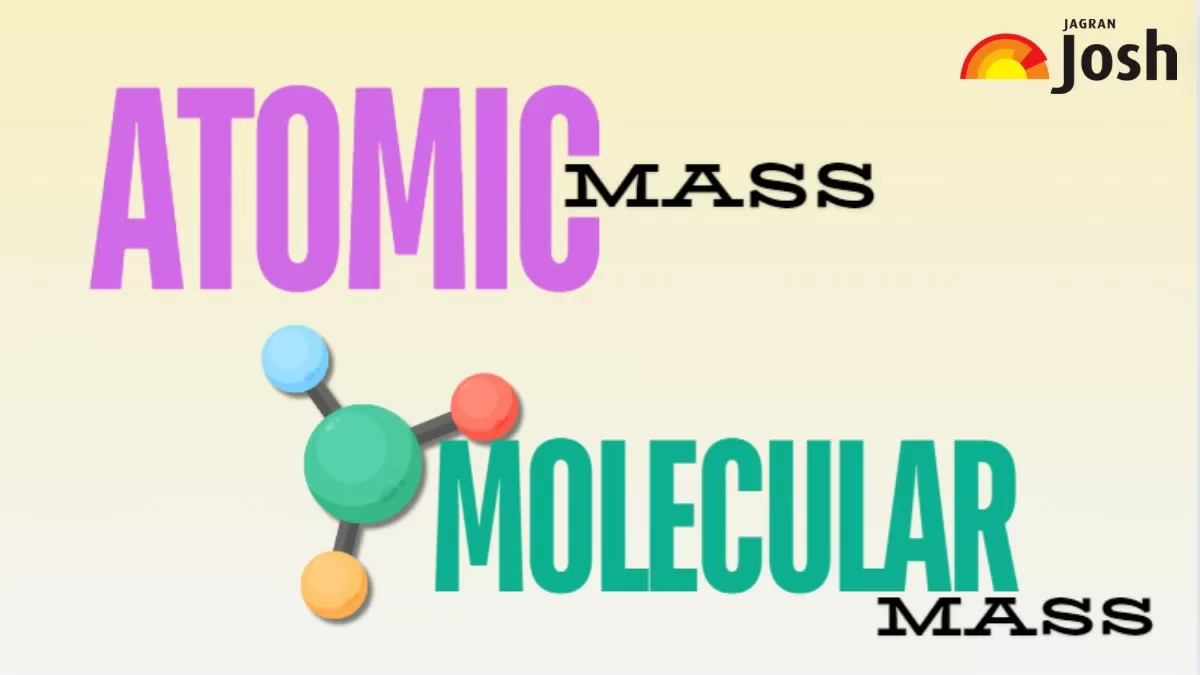Molecular and Atomic Mass of Elements: There are various concepts in chemistry that require a basic understanding to see the bigger picture. One such knowledge is knowing the key terminologies and their meanings. For example, what is atomic mass? And, what is molecular mass? The answer to these questions is provided here in simple language. Students from grades 9 to 12 can refer to this information to get a clear idea about these terms.
Atomic Mass of Atom
- Atomic mass refers to the mass of a single atom of an element. It is approximately equal to the sum of the number of protons and neutrons in the atom's nucleus.
- Electrons have negligible mass, so they don't significantly affect the atomic mass.
- The atomic mass is usually measured in atomic mass units (amu), where 1 amu is defined as one-twelfth of the mass of a carbon-12 atom.
>Mass of Neutron = 1.008 amu
>Mass of Proton = 1.00727647 amu
>Mass of Electron = 0.00054 amu
Example:
Calculating the Atomic Mass of Carbon-12:
- Total mass of protons = 6 × 1.0073 amu = 6.0438 amu
- Total mass of neutrons = 6 × 1.0087 amu = 6.0522 amu
- Total mass of electrons = 6 × 0.00055 amu = 0.0033 amu (negligible)
Adding the masses of protons and neutrons:
Total Atomic Mass of Carbon = 6.0438 amu + 6.0522 amu = 12.096 amu
Molecular Mass of Elements
Molecular mass is the sum of the atomic masses of all the atoms in a molecule. For instance, the molecular mass of water (H₂O) is calculated by adding the atomic masses of two hydrogen atoms and one oxygen atom.
Example:
Water (H₂O):
- Hydrogen: 1.008 amu × 2 = 2.016 amu
- Oxygen: 16.00 amu
- Molecular Mass = 2.016 amu + 16.00 amu = 18.016 amu
1 to 30 Elements With Symbols and Atomic Mass
Here is a list of the first 30 elements of the periodic table with their symbols, and atomic masses. Combine their atomic masses to find out the molecular mass of a compound/element formed by the combination of one or two atoms.
| Element | Symbol | Atomic Mass (amu) | |
| 1 | Hydrogen | H | 1.008 |
| 2 | Helium | He | 4.0026 |
| 3 | Lithium | Li | 6.94 |
| 4 | Beryllium | Be | 9.0122 |
| 5 | Boron | B | 10.81 |
| 6 | Carbon | C | 12.01 |
| 7 | Nitrogen | N | 14.01 |
| 8 | Oxygen | O | 16.00 |
| 9 | Fluorine | F | 19.00 |
| 10 | Neon | Ne | 20.18 |
| 11 | Sodium | Na | 22.99 |
| 12 | Magnesium | Mg | 24.31 |
| 13 | Aluminum | Al | 26.98 |
| 14 | Silicon | Si | 28.09 |
| 15 | Phosphorus | P | 30.97 |
| 16 | Sulfur | S | 32.07 |
| 17 | Chlorine | Cl | 35.45 |
| 18 | Argon | Ar | 39.95 |
| 19 | Potassium | K | 39.10 |
| 20 | Calcium | Ca | 40.08 |
| 21 | Scandium | Sc | 44.96 |
| 22 | Titanium | Ti | 47.87 |
| 23 | Vanadium | V | 50.94 |
| 24 | Chromium | Cr | 52.00 |
| 25 | Manganese | Mn | 54.94 |
| 26 | Iron | Fe | 55.85 |
| 27 | Cobalt | Co | 58.93 |
| 28 | Nickel | Ni | 58.69 |
| 29 | Copper | Cu | 63.55 |
| 30 | Zinc | Zn | 65.38 |
Difference in Molecular Mass and Atomic Mass
The table below summarises all the information to help you understand the basic difference between atomic mass and molecular mass.
| Feature | Atomic Mass | Molecular Mass |
| Definition | The mass of a single atom of an element. | The sum of the atomic masses of all the atoms in a molecule. |
| Unit | Atomic mass units (amu) or Daltons (Da). | Atomic mass units (amu) or Daltons (Da). |
| Calculation Basis | Number of protons and neutrons in the atom's nucleus. | Sum of the atomic masses of each atom in the molecule. |
| Example Calculation | Carbon-12 has an atomic mass of 12 amu. | Water (H₂O) has a molecular mass of approximately 18.016 amu (2×1.008 for hydrogen + 16.00 for oxygen). |
| Application | Identifies the mass of individual atoms of elements. | Identifies the mass of molecules, which are combinations of atoms. |
| Representation | Single value for each element (e.g., C: 12.01 amu). | Sum of atomic masses of constituent atoms (e.g., H₂O: 18.016 amu). |
Related:
